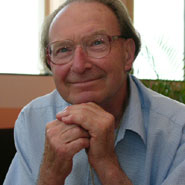Andrew Lang, Emeritus Professor of Physics at the University of Bristol, died June 30 2008.
Distinguished for his pioneering studies in X-ray diffraction physics, especially for his development of the technique of X-ray topography, Professor Lang will be greatly missed by many researchers for his detailed knowledge of crystal physics. Crystals are regular three-dimensional arrays of atoms, packed together in evenly spaced unit cells. Departures from regularity, or crystal defects, significantly modify the useful physical properties of industrial materials, such as their strength, colour and electrical conductivity. Lang developed topographic techniques to image certain imperfections in crystals: such as dislocations, stacking faults, growth-sector boundaries and ferromagnetic domains. One such technique, the projection topograph, displays the internal imperfections throughout a crystal and this is often called the ‘Lang method’. For the past fifty years, Lang’s methods have been widely used in the non-destructive assessment of crystals for the electronics, diamond and other industries.
A diffraction pattern may be produced by visible light passing through a fine silk cloth or by X-rays passing through the regular lattice of atoms in a crystal. When a beam of X-rays enters a crystal at particular angles of incidence, it is possible for the planes of atoms to reflect the X-rays (according to Bragg’s law). The waves in the transmitted beam and in the reflected beam may interfere to produce another wave: in effect a moiré pattern. Lang studied many types of X-ray diffraction phenomena, including variations from Bragg’s law, X-ray moiré patterns and other types of fringes. His most important discovery in this category (with Norio Kato in 1959) was that of interference fringes in wedge-shaped perfect crystals, in which the fringe spacing gave a precise measure of the scattering power (or absolute structure amplitude) from a unit cell. Using synchrotron X-radiation, Lang and his research team were also able to measure and to map the small variations in the separation of carbon atoms across a five millimetre synthetic diamond with an accuracy better than one part per million.
Lang also made significant discoveries using other techniques, especially electron microscopy and cathodoluminescence. For the latter, high-energy electrons are directed on to a specimen surface and the visible luminescence is recorded. Using these techniques separately and in combination with X-ray topography, he studied a wide range of crystalline materials, including metals, semiconductors, quartz and diamond. His first published paper (1947) was on the crystal structure of a potassium soap.
His work exhibited sustained innovativeness, craftsmanship in experimentation, and perceptiveness and thoroughness in the analysis of experiments. The topographic images which he produced were of the very highest quality and were often exceedingly beautiful.
Andrew Richard Lang was born in 1924 at St Annes-on-Sea, England. He obtained a First-Class Honours London External BSc in Physics at Exeter in 1944, a London External MSc in 1947 and a Cambridge PhD in 1953. He worked in industrial research in England (Lever Brothers and Unilever Ltd) and in USA (Philips Laboratories, Irvington-on-Hudson, NY). He was Assistant Professor of Physical Metallurgy at Harvard University (1954 -1959) before moving to a Lectureship in Physics at the University of Bristol in 1960. Lang spent the remainder of his career in Bristol, gaining promotion to Reader in 1966 and to Professor of Physics in 1979.
He was Chairman of the American Crystallographic Association Apparatus & Standards Sub-Committee (1957-59); Consultant, Smithsonian Astrophysical Laboratory (1957-59); Associate Editor, Journal of Crystal Growth (1966-91); and Member of the UK SERC Synchrotron Radiation Facility Committee (1976-78). In 1964, he was awarded the Charles Vernon Boys Prize of the Institute of Physics and the Physical Society. He was elected a Fellow of the Royal Society in 1975 and was awarded the Royal Society Hughes Medal in 1997. In 1996 he was elected Honorary Fellow of the Royal Society of South Africa and in 2005 he was awarded the Ernst Mach Honorary Medal for Merit in the Physical Sciences by the Czech Academy of Sciences.
Even after retirement in 1987, Lang’s dedication to research and scholarship was evidenced by his scientific productivity, his support of younger colleagues and his continual presence in the Physics Department at Bristol. Developing from an early age an inquiring mind, when work allowed, he was a keen amateur geologist, he had a deep interest in music, literature, history and historical travel, the countryside and many aspects of natural history. Lang was a generous donor to national and international charities.
Professor Moreton Moore Department of Physics Royal Holloway, University of London
Professor R Evans, FRS Henry Overton Wills Professor of Physics University of Bristol
